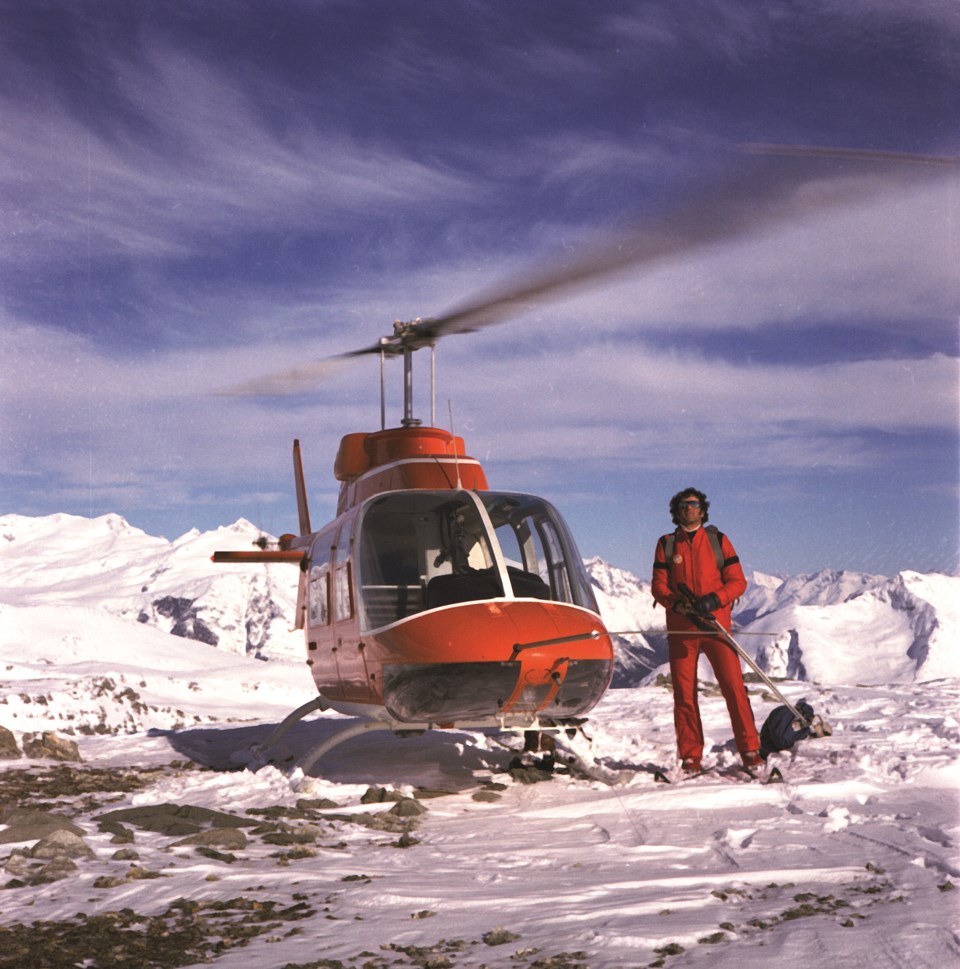The helicopter pulls away, wrapping you in an envelope of swirling crystals. As they dissipate and sound drifts off like a wind dying in the tree-tops, a weight is lifted from your life. Maybe you don’t feel it at first because the void is overtaken by what you see—mountains on every horizon; nothing and no one in sight. But you feel it after that first run. The one where you ski 1,000 vertical metres of snow so light it pours up and over your shoulders like water. It’s the best skiing you’ve done in a lifetime of great skiing. And after hand-wringing over expense, how good it might be, or whether you’d be able to handle it, your preconceptions have been happily dashed on the rocks of reality. With heli-skiing, expectations are so often exceeded they’re almost irrelevant. You’re left with a glow that can last a lifetime. And when you’re taking a dream holiday you’ve looked forward to forever, do you really want it any other way?
This was how ski legend Mike Wiegele, impresario of a well-oiled heli-ski extravaganza staged in the wilds of B.C. for some 50 years now, understood his simple mission: live that dream daily and help guests do the same. When he died on July 15 at the age of 82, both his family and the ski world bid farewell to a man who may not have invented heli-skiing, but whose personality, approach and pioneering efforts at safety, customer service, powder-ski tech and mass-marketing helped make it the alpine juggernaut it became.
Raised on a farm in post-war Austria, Wiegele’s passion for skiing blossomed early and never faltered; humble and poor, he famously cut down a tree at his father’s urging to make skis his parents couldn’t afford. After skiing and racing in his home country, he left for powderier Canada in 1959. Arriving with no English, he worked first as a carpenter before landing a job as a ski instructor at Quebec’s Mont Tremblant. From there he moved west to Sugar Bowl, California, and eventually north to Banff where, in short order, he went from instructor to director of the Lake Louise Ski School. In 1967, he met and married Bonnie Derome, an athlete and businesswoman who’d be key to their future enterprise. But first there were people to teach, racers to coach, and dreams to contemplate.
Shortly after he’d begun exploring the mountains around Banff he met fellow Austrian, moviemaker, guide and heli-ski doyen Hans Gmoser. The two became friends and Wiegele joined Gmoser for ski tours, climbs, forays in front of his camera and heli-skiing. In 1970 Wiegele launched his own heli-ski dream out of Valemont, B.C. But it was the snowier town of Blue River, smack dab between the Monashee and Cariboo Mountains where his vision of a full-scale, internationally renowned heli-ski resort—whimsically labelled Wiegele World by many—would come to fruition.
Waypoints in that journey read like a history of powder-skiing: Wiegele organized the first Powder 8 World Championships in 1978, a fun pairs competition that became an annual right-of-passage for many powderhounds; working with Atomic ski-designer Rupert Huber—who first slapped bindings on the remains of a snowboard he’d cut in half with a bandsaw—Wiegele pioneered the use of fat-skis (remember the Atomic Powder Plus?); he was also the first heli operator to welcome snowboarders. Other outcomes of his determined invention include industry safety standards, avalanche research projects, and the Canadian Ski Guides Association. Wiegele won so many awards over a lifetime of service to skiing, industry and community (including an honorary law degree from Thompsons Rivers University) he could never remember them all. At the core of it, however, remained his deep-seated love of skiing.
I spent some good times at Wiegele World—from watching my childhood ski hero Wayne Wong win a Powder 8 World Championships to springtime attempts at vertical-foot records. But my funnest—and funniest—trip to Blue River was a Powder magazine assignment to report on two wholesome, wide-eyed teenagers from North Dakota who’d won a week-long trip to Wiegele’s. To this day “Lighter Than Air” remains one of my most memorable features not so much because of the impression heli-skiing in big, glaciated mountains made on those green Prairie kids (considerable and fittingly transcendent) but for the impression Wiegele’s personal passion and welcoming attitude made. At dinner the first night, the flatlanders who skied behind tractors at home but were now ensconced in a sprawling lodge overlooking a 12-chopper heli-pad seemed overwhelmed by the bounty on offer. They’d just experienced the magic of ordering their first beer (the drinking age of 19 in B.C. had made them de facto adults for the week) when Wiegele himself strolled over to welcome them. Tanned, adorned in natty trademark white cap and offering exotically-accented greetings through a 35-million-vertical-feet-in-25-years (at the time) smile, he was surely a ski god descended to Earth. Only devout Christianity kept the boys from immediately dropping to their knees and licking his feet. After he left, one leaned over the table and, voice cracking in reverence, whispered “That was him!”
Indeed it was. A ski icon may have passed from this world, but the stories and legends that Mike Wiegele spawned live on. As a racer, coach, powder pioneer, businessman, innovator, husband, and father, he’ll be remembered by all for his frequently uttered and resonant motto: Let’s go skiing.
Leslie Anthony is a Whistler-based author, editor, biologist and bon vivant who has never met a mountain he didn’t like. n






